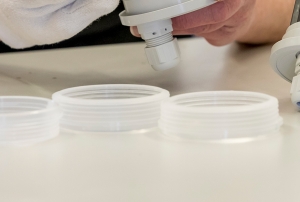Elastomers / Silicones
Elastomers / Silicones (rubber) consist of (ir-)reversibly cross-linked macromolecules, which boasts a high elasticity in the operating temperature range.
The elasticity of most rubbers (e.g. Silicone) can be specifically adjusted by vulcanisation, i.e. the chemical or physical variation of the molecular cross-linking. The Shore hardness is a significant differentiatior as an index for the hardness of an elastomer (according to Albert Ferdinand Shore).
So-called blends (mixtures) of elastomers and thermoplasts are also used as elastic plastics. They are less resistant, but can be thermally processed.
Characteristics
- permanently elastic
- temperature resistant
- oil resistant
Typical applications
- seals (e.g. the seamless liquid silicone seal injected in one piece)
- handles
- medical articles
- car tires
Technical options
- injection moulding and various special processes (esp. foam injection moulding)
- extrusion and various special processes
- vulcanization
Closing forces on Liquid Silicone
The Liquid Silicone machine can be used up to a clamping force of 30 tons.





